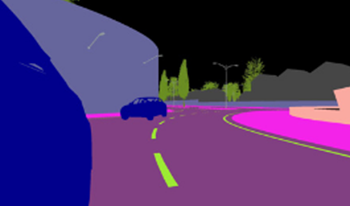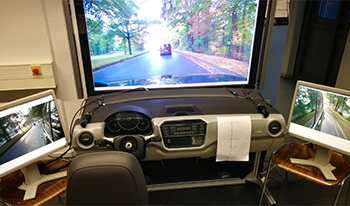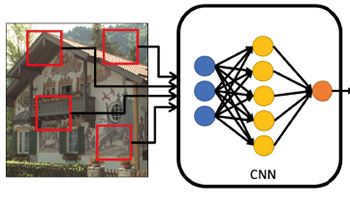

Aliasing effects due to time-discrete capturing of amplitude-modulated light with a digital image sensor are perceived as flicker by humans. Especially when observing these artifacts in digital mirror replacement systems, they are annoying and can pose a risk. Therefore, ISO 16505 requires flicker-free reproduction for 90 % of people in these systems. Various psychophysical studies investigate the influence of large-area flickering of displays, environmental light, or flickering in television applications on perception and concentration. However, no detailed knowledge of subjective annoyance/irritation due to flicker from camera-monitor systems as a mirror replacement in vehicles exist so far, but the number of these systems is constantly increasing. This psychophysical study used a novel data set from real-world driving scenes and synthetic simulation with synthetic flicker. More than 25 test persons were asked to quantify the subjective annoyance level of different flicker frequencies, amplitudes, mean values, sizes, and positions. The results show that for digital mirror replacement systems, human subjective annoyance due to flicker is greatest in the 15 Hz range with increasing amplitude and magnitude. Additionally, the sensitivity to flicker artifacts increases with the duration of observation.

Feature-Product networks (FP-nets) are a novel deep-network architecture inspired by principles of biological vision. These networks contain the so-called FP-blocks that learn two different filters for each input feature map, the outputs of which are then multiplied. Such an architecture is inspired by models of end-stopped neurons, which are common in cortical areas V1 and especially in V2. The authors here use FP-nets on three image quality assessment (IQA) benchmarks for blind IQA. They show that by using FP-nets, they can obtain networks that deliver state-of-the-art performance while being significantly more compact than competing models. A further improvement that they obtain is due to a simple attention mechanism. The good results that they report may be related to the fact that they employ bio-inspired design principles.

Understanding and predicting outdoor visual performance in augmented reality (AR) requires characterizing and modeling vision under strong luminance dynamics, including luminance differences of 10000-to-1 in a single image (high dynamic range, HDR). Classic models of vision, based on displays with 100-to-1 luminance contrast, have limited ability to generalize to HDR environments. An important question is whether low-contrast visibility, potentially useful for titrating saliency for AR applications, is resilient to saccade-induced strong luminance dynamics. The authors developed an HDR display system with up to 100,000-to-1 contrast and assessed how strong luminance dynamics affect low-contrast visual acuity. They show that, immediately following flashes of 25× or 100× luminance, visual acuity is unaffected at 90% letter Weber contrast and only minimally affected at lower letter contrasts (up to +0.20 LogMAR for 10% contrast). The resilience of low-contrast acuity across luminance changes opens up research on divisive display AR (ddAR) to effectively titrate salience under naturalistic HDR luminance.

Portable X-ray imaging systems are routinely used by bomb squads throughout the world to image the contents of suspicious packages and explosive devices. The images are used by bomb technicians to determine whether or not packages contain explosive devices or device components. In events of positive detection, the images are also used to understand device design and to devise countermeasures. The quality of the images is considered to be of primary importance by users and manufacturers of these systems, since it affects the ability of the users to analyze the images and to detect potential threats. As such, there exist national standards that set minimum acceptable image-quality levels for the performance of these imaging systems. An implicit assumption is that better image quality leads to better user identification of components in explosive devices and, therefore, better informed plans to render them safe. However, there is no previously published experimental work investigating this.
Toward advancing progress in this direction, the authors developed the new NIST-LIVE X-ray improvised explosive device (IED) image-quality database. The database consists of: a set of pristine X-ray images of IEDs and benign objects; a larger set of distorted images of varying quality of the same objects; ground-truth IED component labels for all images; and human task-performance results locating and identifying the IED components. More than 40 trained U.S. bomb technicians were recruited to generate the human task-performance data. They use the database to show that identification probabilities for IED components are strongly correlated with image quality. They also show how the results relate to the image-quality metrics described in the current U.S. national standard for these systems, and how their results can be used to inform the development of baseline performance requirements. They expect these results to directly affect future revisions of the standard.